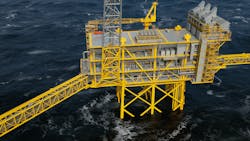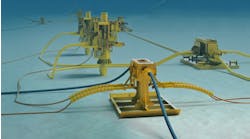Jeremy Beckman, Editor, Europe
Jessica Stump, Assistant Editor
After 30 years of production resulting in subsidence of the underground, the Tyra facilities in the Danish North Sea are being redeveloped to ensure continued production from Denmark’s largest gas field.
With a budget of approximately DKK 21 billion ($3.2 billion), the redevelopment represents the largest project investment ever made in the Danish North Sea, enabling the Tyra field to continue operations for at least 25 years.
Tyra is the center of Denmark’s national energy infrastructure, processing 90% of the nation’s gas production. At peak production, the redeveloped Tyra gas field will provide enough gas to supply what corresponds to 1.5 million Danish homes.
The Tyra Redevelopment project is led by Morten Hesselager Pedersen, Total E&P Denmark. Total is the operator of the Danish Underground Consortium which is responsible for 85% of the oil and 97% of the gas production in Denmark.
“Natural gas is a cornerstone of Total’s strategy tackling climate change,” said Pedersen. “Total expects natural gas to make up as much as 60% of the oil and gas mix within 20 years, and the redevelopment of Tyra is key in securing the future energy mix in Denmark.”
According to Pedersen, the redeveloped Tyra will be a modern oil and gas platform and export center with the newest technology designed to facilitate safe and efficient production. Online condition and performance monitoring are expected to improve maintenance. Around 100,000 sensors will monitor critical equipment on a continuous basis, optimizing both maintenance and operations while also improving safety.
“All data will be instantaneously available onshore, for instance, information about performance and the condition of key equipment. This allows experts to continuously monitor operations and we certainly expect this to increase efficiency and reduce disturbance of the Control Room offshore,” said Pedersen.
The new Tyra accommodation platform has been designed in close collaboration with offshore workers. The aim is to create a home away from home. He pointed out that safety, efficient workflows, and the general well-being have been key focus areas in designing the platform.
The Tyra Redevelopment project scope combines the removal of old facilities, modification to existing facilities, and construction of new modern facilities.
“The two existing gas processing and accommodation platforms on Tyra East and Tyra West will be replaced by one new processing platform and one new accommodation platform. The four wellhead platforms and two riser platforms will be elevated 13 m [43 ft] and the existing topsides will be replaced with new ones,” he explained. “The unmanned satellite platforms in the area have not been affected by subsidence and will therefore generally not be modified.”
A unique component of the Tyra Redevelopment project, according to Pedersen, is the scope of the modification to the wellhead and riser platforms.
“The existing wellhead and riser jackets will be modified and reused. We will be removing the wellhead and riser topsides and installing new ones with an added elevation of 13 m,” he said, “which to my knowledge has never been done in the North Sea before.”
The new topsides for the wellhead and riser platforms are heavier than the existing ones as more piping is required to support the new bridges. Since 2016, engineering analysis has been performed to reasses and ensure sufficient jacket strength capacity. However, the jackets are more sensitive to the horizontal impact from the wave load than the actual weight from the topsides itself.
Production from Tyra is planned to be temporarily shut-in in September 2019 to enable the subsided topsides to be removed in May 2020.
Besides the Tyra West and Tyra East main platforms, six satellites are connected to the Tyra hub for gas export. These will all be closed in for the entire period of the Tyra Redevelopment. The Southern fields including Dan, Halfdan and Gorm and their associated satellites, which produce primarily oil, will maintain production.
“To enable gas export from these fields, a new 26-in. by-pass pipeline has been installed connecting the Dan field to the Dutch sector,” he said. “This way all gas export from the Southern oil fields will be exported to the Netherlands during the Tyra shutdown.”
Additionally, another new 8-in. pipeline has been laid to provide fuel gas to the Gorm field. Today, Gorm is connected to Tyra, but as the field is shut-in, an alternative solution had to be put in place for it to continue production, Pedersen said.
The wells suspension work started in April 2019. Fifty-six wells will be suspended and 44 will be retained and brought back online after production restarts in 2022. Currently, 29 of the planned 56 wells have been suspended and 23 christmas trees and wellheads capped in preparation for the topsides removal campaign in 2020. The christmas trees will be refurbished onshore by Unity, a local Danish vendor, while all wellheads have been grit-blasted and repainted offshore and will remain in their current position.
The Tyra field requires redevelopment due to subsidence of the chalk reservoir that has caused the platforms to sink by around 5 m (16 ft) over the last 30 years. To reinforce the platforms Maersk Oil, now Total, took different measures from 1998-2015. According to Pedersen, safety was the biggest driver of the decision to redevelop Tyra. Despite significant effort to reinforce the current infrastructure and make alternative arrangements for offshore personnel during the worst winter storms, the situation now requires significant new investment to fortify Tyra for further decades of operation and a full redevelopment is necessary.
The design and engineering of the new platforms are accounting for future subsidence and similar chalk reservoirs nearby, for instance, Ekofisk and Valhall.
“The design relies on the historic data which has allowed us to build a reliable model predicting future subsidence which will continue as the result of the gas production from Tyra,” he said. “The air gap on the new Tyra has been designed to enable at least the 25-year design life of the new topsides.”
The detailed engineering began in 2018 following the EPC contractor awards in late 2017. McDermott is delivering the wellhead, riser and process platforms. Rosetti is providing the new accommodation platform. ISC is engineering the new jackets which Dragados is fabricating.
Once the redevelopment has been completed in 2022, Tyra will once again play an important role in the reliable and secure supply of gas to Denmark. •






